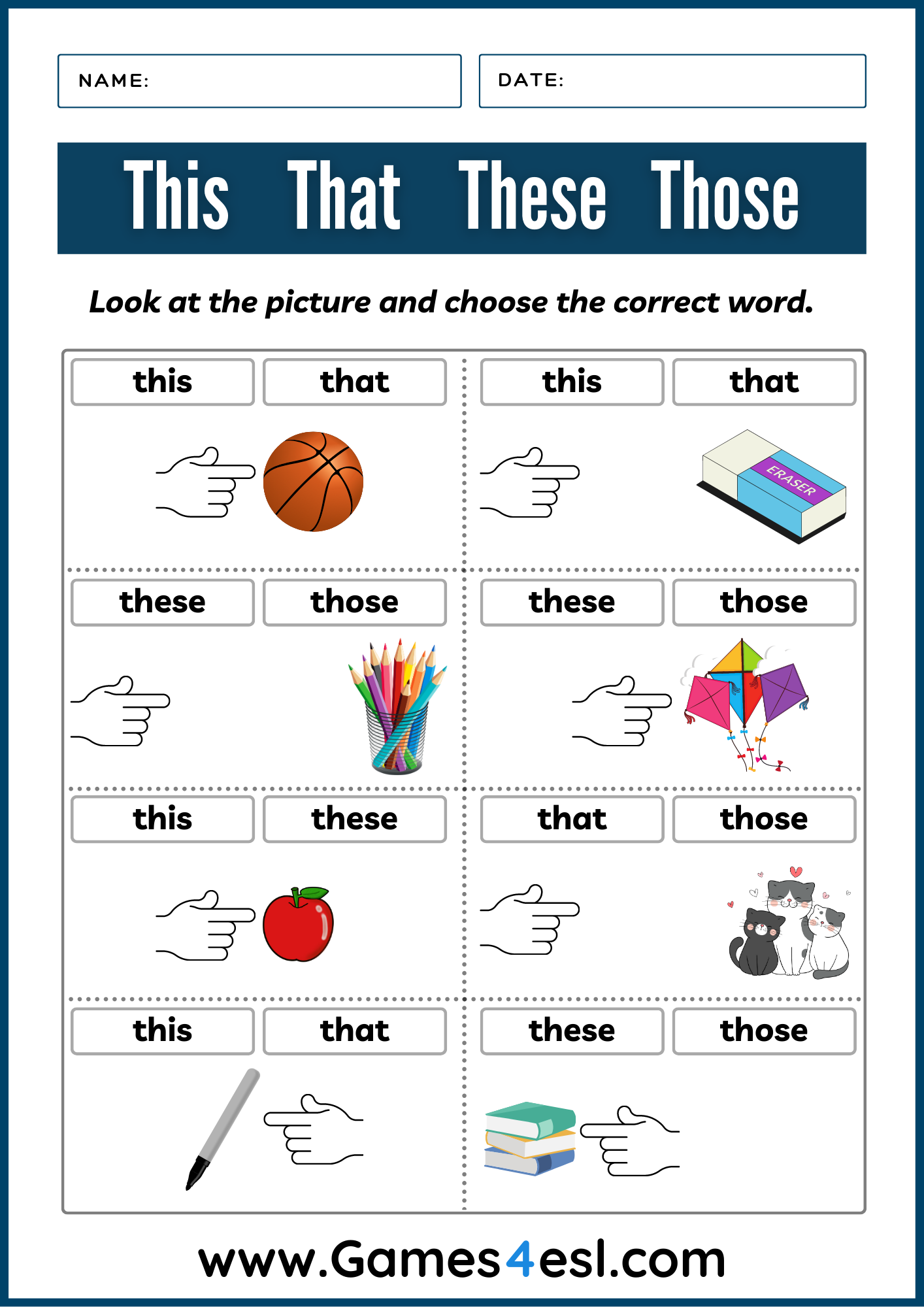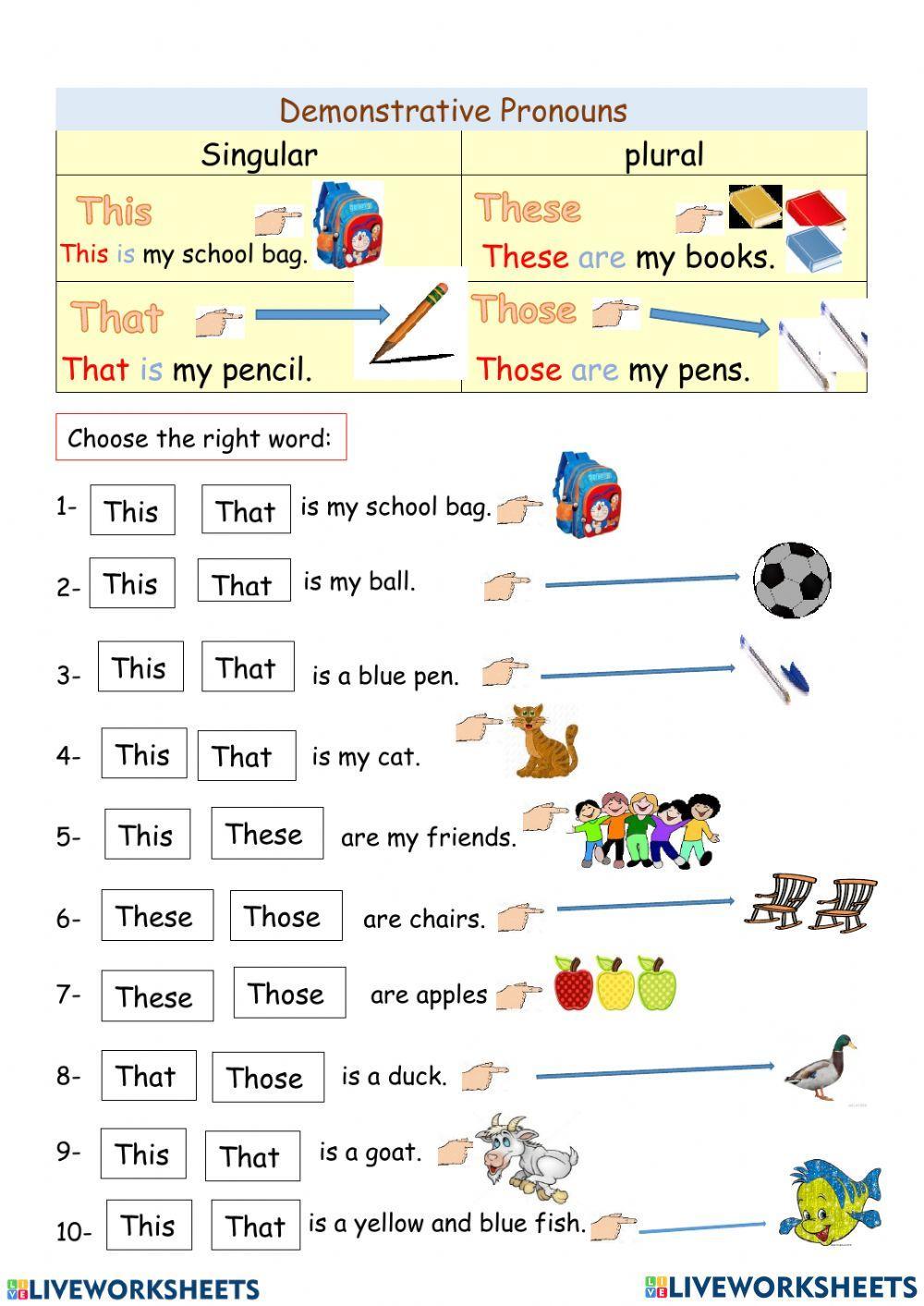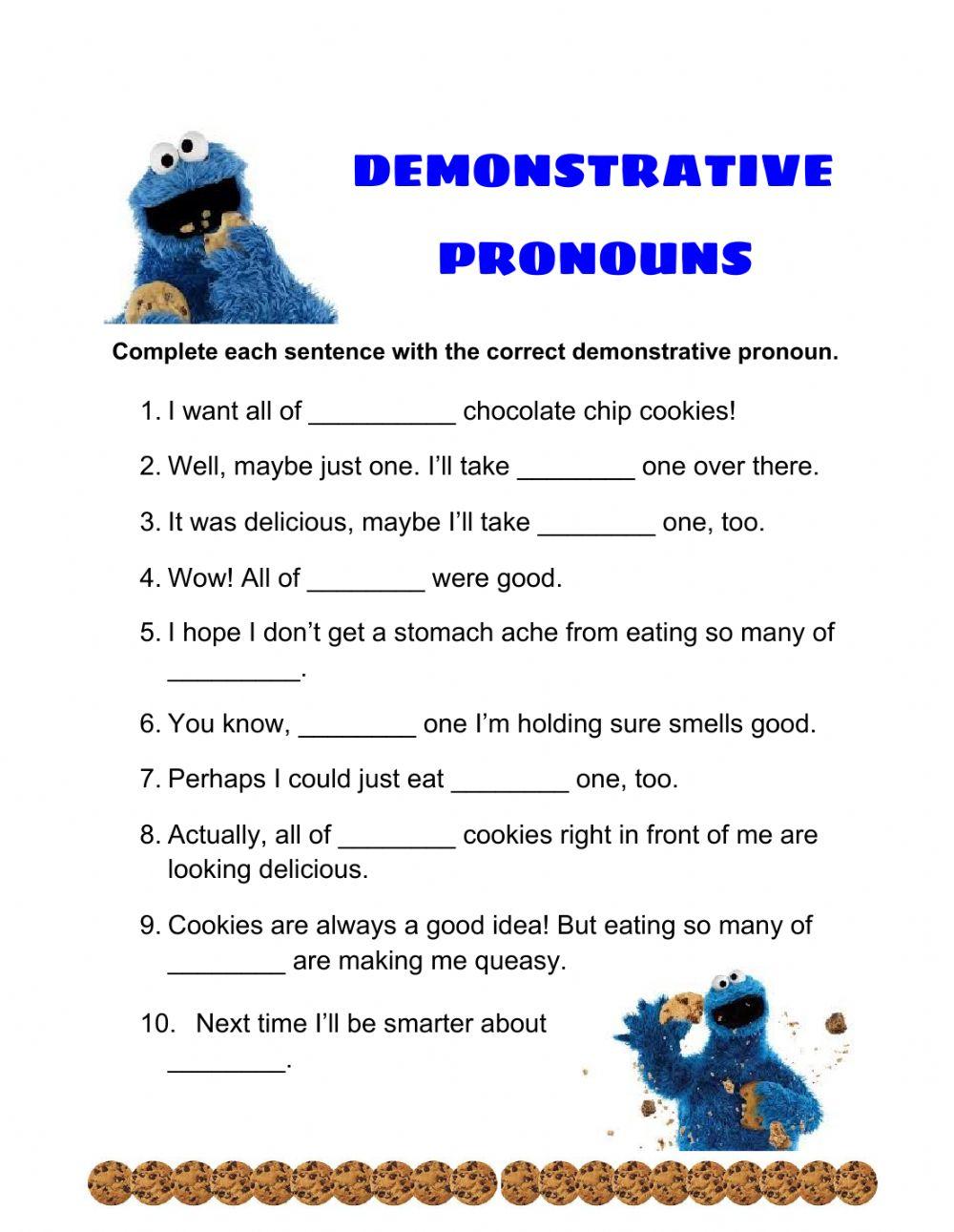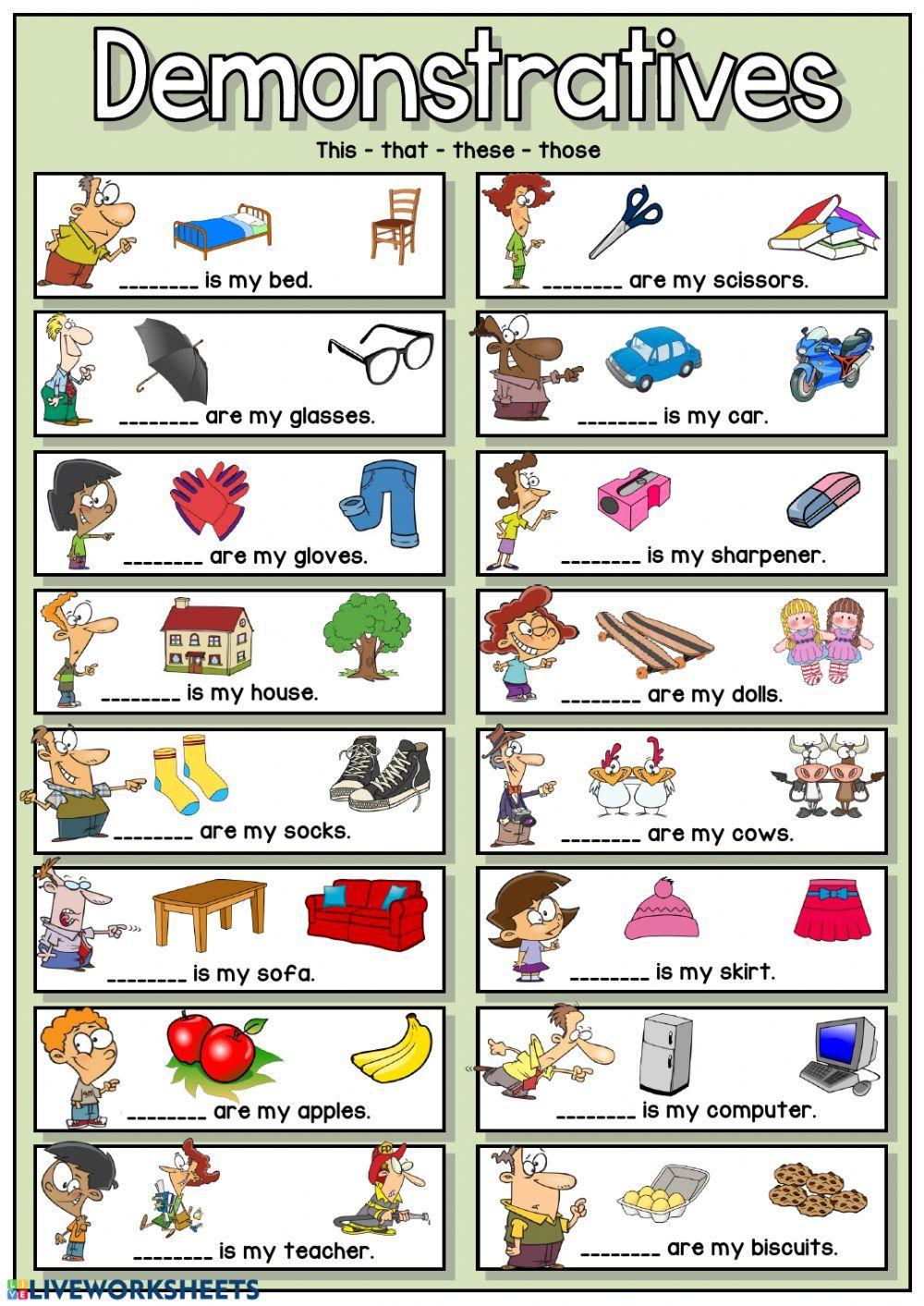
Mastering Proximity and Precision: The Power of Grammar Worksheets: Demonstratives
In the intricate tapestry of the English language, certain grammatical elements act as crucial threads, providing clarity, context, and precision. Among these are demonstratives – this, that, these, and those. These seemingly simple words hold immense power, allowing speakers and writers to point, specify, and differentiate objects, people, and ideas based on their proximity and number. For learners, mastering demonstratives can be a significant hurdle, as their correct application often depends on subtle contextual cues. This is where well-designed Grammar Worksheets: Demonstratives become an indispensable tool, offering structured practice that transforms confusion into competence.
This article delves into the critical role of demonstratives in English grammar, explores the common challenges faced by learners, and illuminates how meticulously crafted Grammar Worksheets: Demonstratives can effectively guide students towards confident and accurate usage.
Understanding the Core: What Are Demonstratives?

At their heart, demonstratives are "pointing words." They indicate whether something is near or far, and whether it is singular or plural. This dual function of indicating both distance and quantity is fundamental to their utility.

The Four Pillars of Demonstratives:

- This: Used for a singular noun that is near the speaker/writer.

- Example: This book is fascinating. (The book is right here.)
- That: Used for a singular noun that is far from the speaker/writer.
- Example: That car looks expensive. (The car is over there.)

- These: Used for plural nouns that are near the speaker/writer.
- Example: These apples are ripe. (The apples are in my hand.)

- Those: Used for plural nouns that are far from the speaker/writer.
- Example: Those birds are singing loudly. (The birds are in the tree across the yard.)



Two Primary Functions:
Demonstratives can function in two key ways, and understanding this distinction is vital for accurate usage:
- Demonstrative Determiners (or Demonstrative Adjectives): When demonstratives are followed immediately by a noun, they act as determiners, modifying the noun and specifying which one is being referred to.
- Examples: This house (singular, near), that tree (singular, far), these shoes (plural, near), those mountains (plural, far).
- Demonstrative Pronouns: When demonstratives stand alone, replacing a noun or noun phrase, they function as pronouns. The noun they refer to is usually clear from the context.
- Examples: "This is my favorite song." (referring to a song previously mentioned or currently playing)
- "Look at that!" (referring to something far away)
- "Are these yours?" (referring to items near the speaker)
- "I prefer those." (referring to items far away or previously mentioned)
The subtle difference between "This book is mine" (determiner) and "This is my book" (pronoun) highlights the need for focused practice, which Grammar Worksheets: Demonstratives are perfectly designed to provide.
The Challenges of Mastering Demonstratives
Despite their apparent simplicity, demonstratives often present a stumbling block for language learners for several reasons:
- Subjectivity of "Near" vs. "Far": What constitutes "near" or "far" can be subjective and context-dependent. Is an item on the other side of the room "near" or "far"? This ambiguity can confuse learners who seek clear-cut rules.
- Abstract Concepts: Demonstratives are not only used for physical objects but also for abstract ideas, events, or time periods. "This idea is brilliant," or "That was a terrible day." Understanding this broader application requires a deeper grasp of contextual meaning.
- Interference from Native Languages: Many languages do not have a direct one-to-one equivalent for all four English demonstratives, or they might use different systems for indicating proximity. This can lead to transfer errors.
- Pronoun vs. Determiner Confusion: Learners might struggle to differentiate when to use a demonstrative as a determiner (followed by a noun) versus a pronoun (standing alone), leading to grammatically incorrect sentences.
- Listening Comprehension: In spoken English, the subtle distinction between this/these and that/those relies on speaker intent and shared context, which can be challenging for non-native speakers to interpret quickly.
These challenges underscore the necessity of targeted, repetitive, and varied practice. This is precisely the void that effective Grammar Worksheets: Demonstratives fill.
The Indispensable Role of Grammar Worksheets: Demonstratives
Worksheets are more than just busywork; they are structured learning tools that offer a multitude of benefits, particularly when tackling specific grammatical points like demonstratives:
- Structured Practice: Worksheets provide a controlled environment for learners to apply rules without the pressure of spontaneous conversation. They break down the learning process into manageable steps.
- Reinforcement of Rules: Repeated exposure to correct usage through various exercises helps solidify the grammatical rules in the learner’s mind. Each correct answer reinforces the concept of proximity and number.
- Contextual Application: Good Grammar Worksheets: Demonstratives present sentences and scenarios that require learners to think about the context to choose the appropriate demonstrative, moving beyond rote memorization.
- Error Identification: Worksheets allow learners to identify their own common errors, facilitating self-correction and deeper understanding. With an answer key, they receive immediate feedback.
- Building Confidence: Successfully completing exercises builds confidence, encouraging learners to use demonstratives more freely and accurately in their speaking and writing.
- Diagnostic Tool: For educators, worksheets serve as an excellent diagnostic tool, revealing areas where students are struggling and informing future lesson planning.
Types of Exercises for Effective Grammar Worksheets: Demonstratives
A comprehensive set of Grammar Worksheets: Demonstratives should incorporate a variety of exercise types to cater to different learning styles and reinforce the concept from multiple angles:
-
Fill-in-the-Blanks (Basic):
- Instructions: Fill in the blank with this, that, these, or those.
- Example: "Look at ____ beautiful flower in my hand." (Answer: this)
- "Can you see ____ stars in the sky tonight?" (Answer: those)
- Benefit: Introduces the core concept and basic application.
-
Picture-Based Exercises:
- Instructions: Look at the picture and complete the sentence using the correct demonstrative. (Pictures show objects near/far, singular/plural).
- Example: (Picture of a single apple on a table near the speaker) "____ is an apple." (Answer: This)
- (Picture of multiple cars far away) "____ cars are fast." (Answer: Those)
- Benefit: Provides visual cues, making the concept of proximity more concrete.
-
Dialogue Completion:
- Instructions: Complete the conversation using appropriate demonstratives.
- Example:
- A: "Can I try ____ shirt?" (pointing to a shirt held by A)
- B: "Sure. ____ one looks good on you."
- Benefit: Simulates real-life interaction, emphasizing contextual usage.
-
Error Correction:
- Instructions: Read the sentences and correct the incorrect demonstrative.
- Example: "That books on the shelf are old." (Correction: Those books)
- "This are my keys." (Correction: These are)
- Benefit: Encourages critical thinking and reinforces correct form.
-
Sentence Transformation:
- Instructions: Rewrite the sentence, changing the proximity or number.
- Example: "This is my pen." (Make it plural and far): "Those are my pens."
- Benefit: Deepens understanding of how changing proximity/number affects the choice of demonstrative.
-
Paragraph/Story Completion:
- Instructions: Read the paragraph and fill in the blanks with the best demonstratives to make sense.
- Benefit: Challenges learners to apply demonstratives within a larger context, promoting cohesion.
-
Determiner vs. Pronoun Identification:
- Instructions: Underline the demonstrative and state whether it is a determiner or a pronoun.
- Example: "This car is new." (Determiner)
- "I like that." (Pronoun)
- Benefit: Explicitly teaches the functional difference.
Crafting Effective Grammar Worksheets: Demonstratives
For educators or self-learners creating their own materials, several principles ensure the effectiveness of Grammar Worksheets: Demonstratives:
- Clear Instructions: Always start with concise and unambiguous instructions.
- Gradual Difficulty: Begin with simpler exercises (fill-in-the-blanks with clear cues) and progressively move to more complex ones (paragraph completion, abstract usage).
- Variety is Key: Mix and match exercise types to keep learners engaged and to test different aspects of understanding.
- Contextual Relevance: Use sentences and scenarios that are relatable and interesting to the target audience. Avoid overly simplistic or abstract examples.
- Visual Aids: For beginning learners, incorporate images to clearly depict "near" and "far" and singular/plural concepts.
- Ample Space: Provide enough room for students to write their answers clearly.
- Answer Key: An answer key is crucial for self-correction and for teachers to quickly check work. Explain why certain answers are correct if possible.
- Differentiation: Create versions of worksheets that cater to different proficiency levels (e.g., simpler versions for beginners, more complex for advanced learners).
Integrating Worksheets into the Learning Process
Grammar Worksheets: Demonstratives are most effective when integrated thoughtfully into a broader learning strategy:
- Pre-Lesson Warm-up: Use a quick worksheet to gauge prior knowledge before introducing the topic.
- During Lesson Practice: After explaining the rules, use worksheets for immediate application and to check understanding.
- Homework/Reinforcement: Assign worksheets for independent practice to consolidate learning outside the classroom.
- Assessment: Use worksheets as a low-stakes assessment to track progress and identify areas needing further attention.
- Self-Study Resource: For independent learners, well-structured worksheets with answer keys are invaluable for self-paced mastery.
Beyond the Basics: Nuances for Advanced Learners
For more advanced learners, Grammar Worksheets: Demonstratives can also explore subtle nuances:
- Temporal Demonstratives: Using this/that to refer to time periods. "I’ve been busy this week." "I remember that day vividly."
- Emotional Distance: Demonstratives can also convey emotional distance or attitude. "I can’t believe that ridiculous statement!" (showing disapproval).
- Referencing Previous Statements: "He said he was leaving. That made me sad." (That refers to the entire previous statement).
- Demonstratives with "One/Ones": "I like this red shirt, but I prefer that blue one."
These more advanced uses highlight the depth and flexibility of demonstratives, providing further opportunities for rich, contextual practice within worksheets.
Conclusion
Demonstratives are small words with significant impact, essential for clear and precise communication in English. While their rules of proximity and number might seem straightforward, their nuanced application in various contexts often proves challenging for learners. This is precisely why Grammar Worksheets: Demonstratives are not merely supplementary materials but foundational tools in the journey toward grammatical mastery.
By offering structured, repetitive, and context-rich practice, these worksheets empower learners to internalize the rules, differentiate between determiners and pronouns, and confidently apply this, that, these, and those in both their spoken and written English. Investing time in well-designed Grammar Worksheets: Demonstratives is an investment in linguistic clarity, ensuring that every "pointing word" hits its mark with precision and purpose.
